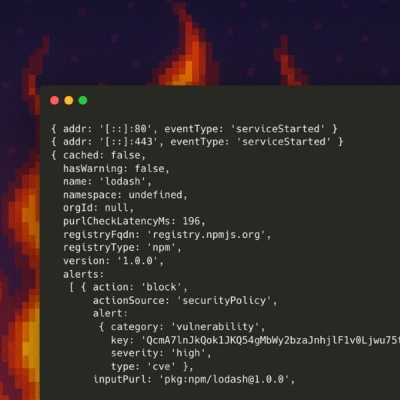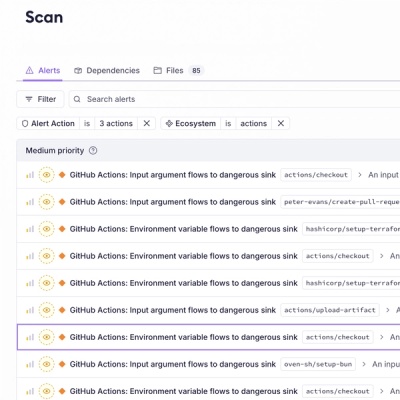
Product
Introducing Socket Firewall Enterprise: Flexible, Configurable Protection for Modern Package Ecosystems
Socket Firewall Enterprise is now available with flexible deployment, configurable policies, and expanded language support.
mongodb-wrapper
Advanced tools
A wrapper for node-mongodb-native as close as possible to the native javascript driver. Why learn two interfaces?
v1.0.0 - A complete rewrite of the driver that now uses mongoclient. The interface is generally the same, but all the messiness of reconnecting has been removed, as thats transparently handeled by the mongo client. If you see any breakage, please open an issue!
npm install mongodb-wrapper
toArray, count, but not find) var mongo = require('mongodb-wrapper')
var db = mongo.db('localhost', 27017, 'test')
db.collection('posts')
db.posts.save({title: "A new post", body: "Here is some text"}, function(err, post) {
db.posts.findOne({_id: doc._id}, function(err, post) {
db.posts.find().limit(1).toArray(function(err, posts) {
// posts[0].title == "A new post"
})
})
})
For more examples, please look at the test suite
Remember the guiding principle: the syntax exactly matches the command-line driver, except you pass a call back to any function that hits the database.
There are lots of ways to open up a database connection
mongo.db(mongodbConnectionString) - returns a database object, for details on the connection string see mongodb docs
NOTE: this mode does not support a prefix!
mongo.db(host, port, dbname, [prefix], [username], [password]) - returns a database project
If prefix is specified all collections will use the prefix in mongo, but you refer to them without the prefix in node.
If username and password are specified, it will attempt to authenticate.
db.collection(name) - Returns a Collection object. Also creates db[name] so you can do this:
db.collection('users')
db.users.count(cb)
Replica sets are also supported with an alternate function signature:
var hostsArray = [
// opts is a hash of mongodb-native server opts: http://mongodb.github.com/node-mongodb-native/api-generated/server.html
// also optional
{host: "host1", port: 27017, opts: {}},
{host: "host1", port: 27018, opts: {}},
...
]
// other replica set opts, such as read_secondary, are passed in here
// these opts are also passed to each mongodb-native server object, so you can have defaults for your servers
var opts = {rs_name: "myReplicaSet"}
mongo.db(hostsArray, opts, dbname, [prefix], [username], [password])
db.auth(username, password, cb) - You can pass username and password into mongo.db instead of calling this manually
db.addUser(username, password, cb)
db.removeUser(username, password, cb)
db.dropDatabase(cb)
db.lastError(cb) - cb(err, lastError)
db.eval(code, [parameters], cb)
db.createCollection(name, options, cb) - allows you to create a collection by hand if you want to specify the options
collection.ensureIndex(index, options, cb)
collection.dropIndexes(cb)
collection.renameCollection(newName, dropTarget, cb)
collection.insert(doc(s), cb)
collection.remove(selector, cb)
collection.drop(cb)
collection.save(doc, cb)
collection.update(selector, updates, [upsert], [multi], cb)
collection.count(cb)
collection.findAndModify(options, cb)
collection.find(selector, fields) - Returns a Cursor
collection.findOne(selector, fields, cb)
collection.group(options, cb)
collection.mapReduce(map, reduce, options, cb) - map and reduce can be functions, it will toString them for you.
collection.distinct(key, [query], cb)
cursor.limit(num)
cursor.skip(num)
cursor.sort({field:1})
cursor.next(cb)
cursor.explain(cb)
cursor.toArray(cb)
cursor.count(cb)
cursor.getRawCursor - retrieves a raw mongodb-native cursor, so you can do things like cursor streams, and other fancy things not supported
mongo.ObjectID - you need to wrap any string ids in this class to match on _id
FAQs
Exactly-like-the-console wrapper for node-mongodb-native
We found that mongodb-wrapper demonstrated a not healthy version release cadence and project activity because the last version was released a year ago. It has 2 open source maintainers collaborating on the project.
Did you know?

Socket for GitHub automatically highlights issues in each pull request and monitors the health of all your open source dependencies. Discover the contents of your packages and block harmful activity before you install or update your dependencies.

Product
Socket Firewall Enterprise is now available with flexible deployment, configurable policies, and expanded language support.

Security News
Open source dashboard CNAPulse tracks CVE Numbering Authorities’ publishing activity, highlighting trends and transparency across the CVE ecosystem.

Product
Detect malware, unsafe data flows, and license issues in GitHub Actions with Socket’s new workflow scanning support.